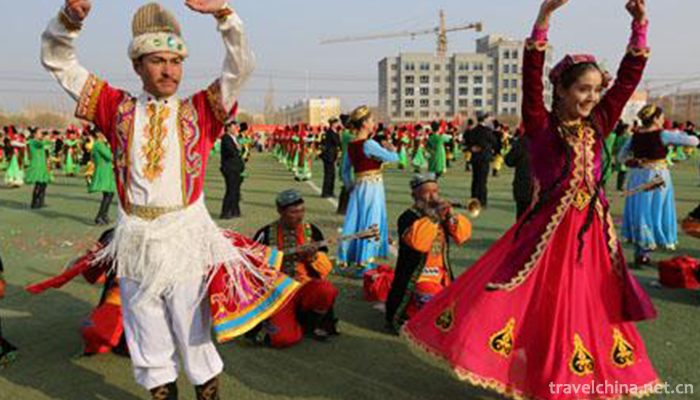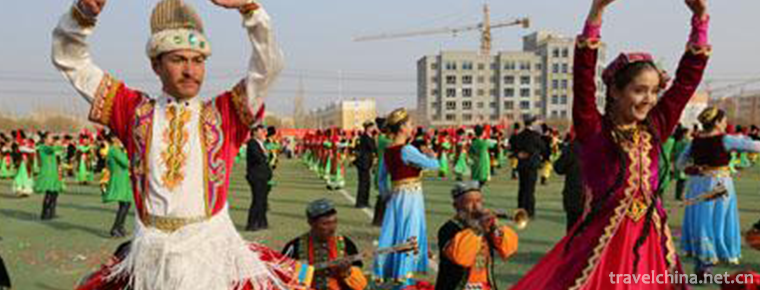Sama Dance
Sama Dance
Sama dance is a kind of folk dance that the Uygur working people dance together during the New Year's Festival. Its movements are simple and powerful. It is mainly popular in Kashgar and Shache of Southern Xinjiang.
May 23, 2011 was listed in the third batch of national intangible cultural heritage list by the State Council.
Historical Evolution
Samaben is the name of a primitive religion, which was once believed by the ancient Uygur people. At that time, due to the extremely backward productivity, people prayed for the harvest of hunting and agriculture to various gods of nature in the form of songs, drums and dances under the organization of full-time priest, Sama.
With the development of productivity and the change of economic life, it has gradually evolved from sacrificial rituals to collective entertainment activities during the working people's New Year's Day, and then to a unique form of folk dance. In addition to the New Year's Day, Sama dances are sometimes performed on general occasions of celebration. Sama dances and music are also absorbed in the beginning of the third part of the twelve Muqam, Messilev.
After the introduction of Islam into Xinjiang, the rulers also used Sama as a folk dance form for religious activities. For example, the action of raising both hands is interpreted as "Huda (God) in heaven" and the action of holding one hand to the chest is interpreted as "Huda is in the heart".... Although Sama dances are played by suona and drums, no laughter is allowed. The mood of the dancers and the atmosphere of the dance are solemn and solemn. The Sama held in the Temple House had no music. With the prayer of Amu, she was dancing and shouting rhythmically "Ooh - Ooh!" But in the folk entertainment occasions, when people dance Sama, they are still full of happy atmosphere. After liberation, they jumped more vigorously. ?
Dance features
In the early morning of Kurban Festival, the crisp sound of iron drums drifted to thousands of families along with the warm morning breeze. People dressed in costumes poured from all directions to the Plaza of the Great Church Temple to celebrate traditional festivals. Everyone danced the Samar dance with the clear and powerful Samar tune and the rhythm of the iron drum. Dancers follow the counter-clockwise direction, with the drum point "thump" strong tone to start, and gradually the rhythm turns fast, the drum sound becomes more powerful, the movement also turns to fierce and enthusiastic, many people began to do Sama dance unique continuity of jumping and other technical movements. The audience and the dancers echoed each other, and the mood became higher and higher. Finally, the dance ended in a jubilant chorus.
Most of the participants were men and sometimes women, but all of them danced together by themselves. Samar dancing is steady and solid, full of the breath of labor and life.
The movements of Sama dance and the rhythm of drums are closely coordinated. "Bah" time is mostly full foot landing, stable and powerful, not rigid and not immediately raised, with the effect of a note. When the power leg is lifted, the knee of the main leg has obvious flexion and extension, and the body undulates greatly. ?
Most of the hands are semi-clenched fists in natural form, which have obvious leisureliness when they are thrown open and bent back. With the swing of the hand, the body has the feeling of slightly shaking left and right. One-step skipping, one-step skipping, one-step skipping and so on are common skills in Sama. ?
Samar has a special tune. It usually starts with the familiar music of Mukam or Thanem, and then turns to Samar as the rhythm of the drum changes.
The music rhythm of Sama Dance is vigorous and powerful, and it has its own characteristics. Basically, it can be divided into the following rhythms:
The main instruments accompanying Sama are Suona and drum. The number of suonas varies. The drum is composed of two drums with different pitches, which produce the sound of "thump" and "dang", forming a sharp contrast. In large occasions, sometimes there are two or three groups, plus a bigger drum with more rich timbre, highlighting the sound effect of "drum". The rhythm of drum determines the harmony and unity of dance speed and movement. Experienced drummers make the drumbeating varied and inspire the mood of the dancers and the audience. Suona plays a more flexible tune, not limited by the drum, sometimes dragging two or three bars of long notes, or three or four bars of intervals to highlight the rhythm of the drum.
Current status of protection
Kashgar "Samar Dance" was listed in the third batch of national intangible cultural heritage list by the State Council on May 23, 2011. It is the only national intangible cultural heritage protection project in Kashgar. It is listed as the five major citizens along with the Uygur traditional "Saim Dance", "Daolang Dance", "Shadiana Dance" and "Nazurkumu" dance. One of the dances between Uygurs is the most representative group dance for celebration.


-
1.Beijing Hangzhou Grand Canal
Beijing-Hangzhou Grand Canal is the longest and largest ancient canal in the world. It is also one of the oldest canals. It is called three great projects in ancient China together with the Great Wall
Time 2018-12-22 -
2.The Ancient City of Gaochang
Gaochang City, which began in the first century B.C., was built by the army of Tuntian in the territory of Cheshi in the Western Han Dynasty. The site of the Old Town is located in the vicinity of Har
Time 2019-01-12 -
3.Qingdao Polar Ocean World
Qingdao Polar Marine World is located at 60 Donghai East Road, Laoshan District, Qingdao City, Shandong Province. It is a large marine world complex integrating leisure
Time 2019-02-07 -
4.Shenyang Weipo Skiing Ground
Shenyang Qiaopo International Skiing Resort is located in AAAA Scenic Area of Qiaopo in Shenyang, which is surrounded by mountains in the northeast direction and boundless forest sea.
Time 2019-02-08 -
5.The Site of the Ancient Great Wall of the Warring States Period
When people mention the Great Wall, they will think of the Great Wall from Shanhaiguan to Jiayuguan. However, in Xilingol League, there are also the ancient Great Wall, which is not as famous as the G
Time 2019-03-09 -
6.Bemo painting
Bimo Painting of the Yi Nationality is a kind of picture on paper or animal skin, bark, bamboo slips, stone, wooden boards and other carriers painted by Bimo, a priest of the Yi Nationality.
Time 2019-04-04 -
7.Zamuni of Tibetan Nationality Playing and Singing
"Zamuni" is also called the Six Stringed Orchestra, a traditional Tibetan plucked instrument. Mainly spread in Lhasa, Shannan, Ali, Lazi (Bahir), Sakya, Angren, Dingri and other places
Time 2019-04-15 -
8.The Legend of Shun
Shun was born in Zhufeng Village, Yongji County. His surname is Yao and his name is Chonghua because of his double pupils. Soon after his mother gave birth, he died. His father married a stepmother an
Time 2019-06-16 -
9.Butter Flowers in Tar Temple
Butter flower originated from Benjiao religion in Tibet. It is a small decal on the food supply. According to traditional Indian Buddhist customs, the tributes offered to Buddhas and Bodhisattvas are
Time 2019-06-17 -
10.Legend of Wang Xizhi
Wang Xizhi's legend is a local folklore in Shaoxing City, Zhejiang Province. Wang Xizhi has few words. Jin Dynasty, one of the most famous calligraphers in China, once served as a general of the Right
Time 2019-06-26 -
11.Environmental protection in Mianyang
In 2018, the water quality of Fujiang, Kaijiang, Zijiang, Anchang River, Furong River, Tongkou River and Luban reservoir in Mianyang City accounted for 100% of the total water quality. Among them, Fujiang River, Tongkou River, Zijiang River and Anchang
Time 2020-12-14 -
12.Guangan scenic spot
By 2018, there are 24 A-level scenic spots in Guang'an City, of which Deng Xiaoping's hometown is a national 5A scenic spot, and six scenic spots, including Huaying Mountain tourist area, Shenlong mountain Ba Ren stone city, baozhensai, Tianyi Vall
Time 2020-12-19